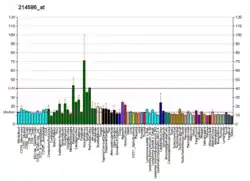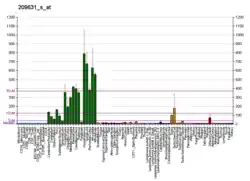GPR37
Probable G-protein coupled receptor 37 is a protein that in humans is encoded by the GPR37 gene.[4][5]
Interactions
GPR37 has been shown to interact with HSPA1A[6] and Parkin (ligase).[6][7] GPR37 is a receptor for prosaposin. It was previously thought to be a receptor for head activator, a neuropeptide found in the hydra, but early reports of head activator in mammals were never confirmed.[8]
GPR37 signaling has been shown to modulate the migration of olfactory ensheathing cells (OECs) and gonadotropin-releasing hormone (GnRH) cells in mice.[9]
References
- GRCh38: Ensembl release 89: ENSG00000170775 - Ensembl, May 2017
- "Human PubMed Reference:". National Center for Biotechnology Information, U.S. National Library of Medicine.
- "Mouse PubMed Reference:". National Center for Biotechnology Information, U.S. National Library of Medicine.
- Marazziti D, Golini E, Gallo A, Lombardi MS, Matteoni R, Tocchini-Valentini GP (November 1997). "Cloning of GPR37, a gene located on chromosome 7 encoding a putative G-protein-coupled peptide receptor, from a human frontal brain EST library". Genomics. 45 (1): 68–77. doi:10.1006/geno.1997.4900. PMID 9339362.
- "Entrez Gene: GPR37 G protein-coupled receptor 37 (endothelin receptor type B-like)".
- Imai Y, Soda M, Hatakeyama S, Akagi T, Hashikawa T, Nakayama KI, Takahashi R (July 2002). "CHIP is associated with Parkin, a gene responsible for familial Parkinson's disease, and enhances its ubiquitin ligase activity". Molecular Cell. 10 (1): 55–67. doi:10.1016/S1097-2765(02)00583-X. PMID 12150907.
- Imai Y, Soda M, Inoue H, Hattori N, Mizuno Y, Takahashi R (June 2001). "An unfolded putative transmembrane polypeptide, which can lead to endoplasmic reticulum stress, is a substrate of Parkin". Cell. 105 (7): 891–902. doi:10.1016/S0092-8674(01)00407-X. PMID 11439185. S2CID 721363.
- Meyer, Rebecca C.; Giddens, Michelle M.; Schaefer, Stacy A.; Hall, Randy A. (4 June 2013). "GPR37 and GPR37L1 are receptors for the neuroprotective and glioprotective factors prosaptide and prosaposin". Proceedings of the National Academy of Sciences. 110 (23): 9529–34. Bibcode:2013PNAS..110.9529M. doi:10.1073/pnas.1219004110. PMC 3677493. PMID 23690594.
- Saadi H, Shan Y, Wray S (2019). "GPR37 Signaling Modulates Migration of Olfactory Ensheathing Cells and Gonadotropin Releasing Hormone Cells in Mice". Frontiers in Cellular Neuroscience. 13: 200. doi:10.3389/fncel.2019.00200. PMC 6521704. PMID 31143101.
Further reading
- Zeng Z, Su K, Kyaw H, Li Y (1997). "A novel endothelin receptor type-B-like gene enriched in the brain". Biochemical and Biophysical Research Communications. 233 (2): 559–67. doi:10.1006/bbrc.1997.6408. PMID 9144577.
- Donohue PJ, Shapira H, Mantey SA, Hampton LL, Jensen RT, Battey JF (1998). "A human gene encodes a putative G protein-coupled receptor highly expressed in the central nervous system". Molecular Brain Research. 54 (1): 152–60. doi:10.1016/S0169-328X(97)00336-7. PMID 9526070.
- Imai Y, Soda M, Inoue H, Hattori N, Mizuno Y, Takahashi R (2001). "An unfolded putative transmembrane polypeptide, which can lead to endoplasmic reticulum stress, is a substrate of Parkin". Cell. 105 (7): 891–902. doi:10.1016/S0092-8674(01)00407-X. PMID 11439185. S2CID 721363.
- Imai Y, Soda M, Hatakeyama S, Akagi T, Hashikawa T, Nakayama KI, Takahashi R (2002). "CHIP is associated with Parkin, a gene responsible for familial Parkinson's disease, and enhances its ubiquitin ligase activity". Molecular Cell. 10 (1): 55–67. doi:10.1016/S1097-2765(02)00583-X. PMID 12150907.
- Yang Y, Nishimura I, Imai Y, Takahashi R, Lu B (2003). "Parkin suppresses dopaminergic neuron-selective neurotoxicity induced by Pael-R in Drosophila". Neuron. 37 (6): 911–24. doi:10.1016/S0896-6273(03)00143-0. PMID 12670421. S2CID 8430695.
- Imai Y, Soda M, Murakami T, Shoji M, Abe K, Takahashi R (2003). "A product of the human gene adjacent to parkin is a component of Lewy bodies and suppresses Pael receptor-induced cell death". Journal of Biological Chemistry. 278 (51): 51901–10. doi:10.1074/jbc.M309655200. PMID 14532270.
- Kubota K, Niinuma Y, Kaneko M, Okuma Y, Sugai M, Omura T, Uesugi M, Uehara T, Hosoi T, Nomura Y (2006). "Suppressive effects of 4-phenylbutyrate on the aggregation of Pael receptors and endoplasmic reticulum stress". Journal of Neurochemistry. 97 (5): 1259–68. doi:10.1111/j.1471-4159.2006.03782.x. PMID 16539653. S2CID 24540976.
- Omura T, Kaneko M, Okuma Y, Orba Y, Nagashima K, Takahashi R, Fujitani N, Matsumura S, Hata A, Kubota K, Murahashi K, Uehara T, Nomura Y (2006). "A ubiquitin ligase HRD1 promotes the degradation of Pael receptor, a substrate of Parkin" (PDF). Journal of Neurochemistry. 99 (6): 1456–69. doi:10.1111/j.1471-4159.2006.04155.x. hdl:2115/17141. PMID 17059562. S2CID 6256027.
This article is issued from Wikipedia. The text is licensed under Creative Commons - Attribution - Sharealike. Additional terms may apply for the media files.



